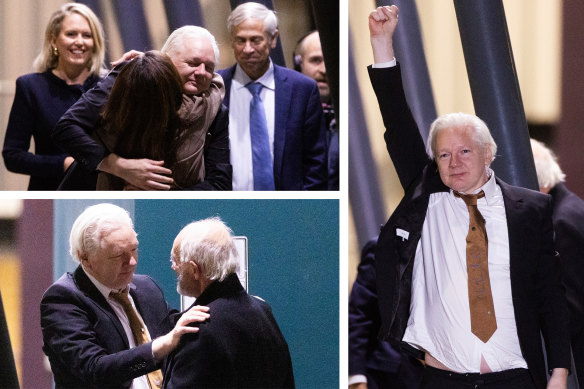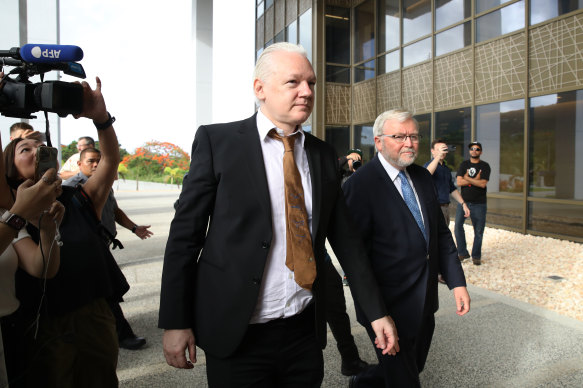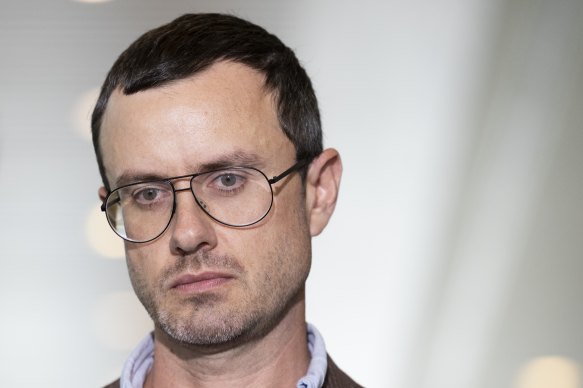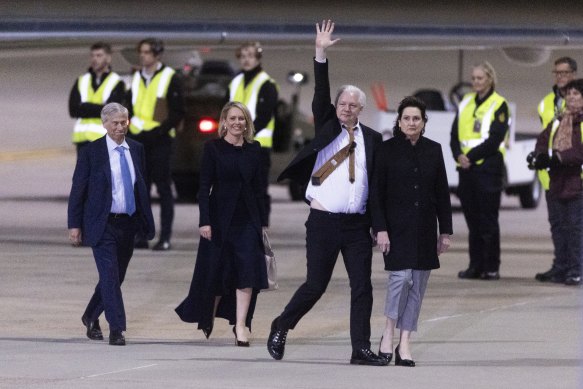This was published 8 months ago
Inside the secret talks to bring Assange home
This was an ultramarathon with a final sprint at the end.
By David Crowe and Matthew Knott

WikiLeaks founder Julian Assange returned to Australia in emotional scenes in Canberra on Wednesday night.Credit: Alex Ellinghausen
Australian officials issued a legal deed last week to clear a final hurdle in bringing WikiLeaks founder Julian Assange home from years in prison over American claims of espionage.
Assange, once called the “most wanted man in the world” for releasing hundreds of thousands of top-secret documents, had struck a plea deal with United States prosecutors that could end the case and ensure his freedom.
But the Australian government had to pay for an extraordinary journey that would take Assange from a high-security prison in the United Kingdom to a remote island in the Pacific, where he would plead guilty in a US court before flying on to Canberra to be reunited with his wife, two children and father.
The legal deed required Assange to repay taxpayers for the $780,000 expense of the charter flight and its related costs, giving the government the confidence it needed to start the headlong rush to bring him home.
“The final plea deal was agreed in the week before we got on the plane, after a huge amount of back and forth in the final weeks,” says Jennifer Robinson, the Australian lawyer who has represented Assange since 2010.
This was an ultramarathon with a final sprint at the end.
Prime Minister Anthony Albanese led a diplomatic effort over two years to resolve the long dispute and raised it with US President Joe Biden several times, but the Australian government had no part in the plea deal.
Australian officials confirm the agreements only fell into place early last week. That is when the government could be confident of arranging the VistaJet charter flight to the US territory of Saipan, the location chosen by the US Department of Justice for Assange to plead guilty to espionage.
Assange was adamant at first that he would not set foot on American soil and his team argued as recently as six weeks ago that he could appear in court by video rather than fly halfway across the world.
On this, however, the US would not budge. It was essential to the Department of Justice that Assange plead guilty to a felony – and the law meant he had to do this on US territory before a US judge.
Saipan, an island 3000 kilometres north of Cape York, was the compromise. The Assange team, with US counsel Barry Pollack as well as Robinson and her colleague Gareth Peirce, accepted this because it meant their client would not go to the US mainland and would be in Australian airspace as soon as possible after leaving court.
The Australian high commissioner to the UK, former foreign affairs minister Stephen Smith, had to accompany Assange on the flight. The ambassador to the US, former prime minister Kevin Rudd, arranged to fly to Saipan to meet the charter jet.
Astonishingly, all sides kept this extraordinary journey secret. The news only broke when Assange was on the flight on Monday night, local time, after he had been granted bail by the UK High Court in a secret hearing last week. The news was leaked in the US capital, dashing hopes in the Assange team that they could get in and out of the Saipan court without a media crush.
False starts
There were false starts on the way to this outcome. Albanese and those around him thought the WikiLeaks founder might have been released weeks ago, but they had to wait for the legal teams on either side to be happy with the details.

WikiLeaks founder Julian Assange is joined by Australia’s US ambassador Kevin Rudd as he arrives at court in Saipan, Northern Mariana Islands.Credit: Getty Images
“We understood the separation of powers,” one of those involved says. “It was complex and it was up to the Department of Justice.”
On Thursday, a candid briefing in Washington, DC, revealed the thinking inside the US legal team. An email seen by The Washington Post showed that attorneys believed they were going to lose their case to extradite Assange to the US, making a plea deal a wiser choice.
“The urgency here has now reached a critical point,” the trial attorney wrote on April 4. “The case will head to appeal and we will lose.”
Assange’s brother, Gabriel Shipton, says he began feeling confident about the outcome in February, when the UK High Court held a two-day hearing on whether Assange could appeal an extradition order to the US. Assange won in May. “There was a radical change in the UK court,” Shipton says.
A plea deal had been on the agenda for some time. This masthead reported in May last year that Assange’s wife, Stella, was open to an agreement. “We are considering all options,” Robinson said at the time. Progress, however, was incredibly slow.
Negotiations sped up at the Department of Justice, Robinson says, after the High Court decision. The plea deal had been talked about for more than six months, but the US side engaged in earnest over the past eight weeks. The Washington Post report helps explain why. Worried about the risk of defeat, the attorneys tried harder to reach a compromise.
Two aspects of the felony now stand out. One is that it makes no mention of hacking, a key claim made by the US against Assange over the years. Another is that it makes no mention of people being harmed, another controversy because of the claims that lives were put at risk when WikiLeaks released secret US military documents and diplomatic cables that named people who assisted the US in wars in countries including Iraq and Afghanistan.

Julian Assange’s brother, Gabriel Shipton, expressed relief at his brother’s safe arrival in Australia.Credit: Alex Ellinghausen
The court hearing also canvassed two crucial points for Assange and his team. One fact, said Chief Judge Ramona Manglona in the District Court for the Northern Mariana Islands, was that Assange had already served at least five years in a high-security prison.
“There’s another significant fact – the government has indicated there is no personal victim here,” the judge added. “That tells me I can surmise that the dissemination of information that occurred in this instance did not result in any known physical injury.”
Assange walked from the court, just as planned, and headed for the charter jet to fly home.
Turning point
Albanese and others in the government had worked for two years for a legal resolution of some kind. While the WikiLeaks support base wanted their hero freed without charge, the government knew there had to be a legal outcome the Department of Justice could accept. But it took a long time coming.
Robinson believes the arrival of the Albanese government in May 2022 was a key turning point – and she told Foreign Minister Penny Wong this during a spontaneous meeting, along with Stella Assange, in the press gallery of Parliament House on Thursday morning as they headed to different media interviews.
“Government after government here did not listen and didn’t do anything, and it was your government that took a different position,” Robinson told Wong.
Wong raised the Assange case within days of taking office, when she met US Secretary of State Antony Blinken in Tokyo in May 2022.
This prepared the way for Albanese to mention it to Biden on the sidelines of a NATO summit in Madrid the next month. He raised it again at meetings with Biden in Hiroshima in May and Washington in October last year.
Attorney-General Mark Dreyfus put the Australian view directly to his US counterpart, Merrick Garland, in a meeting in Washington in February this year. Smith visited Assange in prison, while Rudd lobbied in Washington.
At no point, say those aware of the talks, did the Australian government say how the case should be resolved.
‘Enough was enough’
The message to the Americans was that the case was an irritant in the relationship. This echoed the public position Labor had taken in early 2021 and repeated when it took power the next year – not that Assange should walk free but that his case had gone on too long.
Opposition Leader Peter Dutton has been silent on Assange this week, while Coalition foreign affairs spokesman Simon Birmingham has criticised Albanese for greeting Assange with a phone call when he landed in Canberra.
“He’s been convicted of a crime,” Birmingham said of the WikiLeaks founder. “He’s admitted to that crime, and he should not be receiving that type of special homecoming greeting from our prime minister.”
Crucially, the government never took sides on whether Assange was guilty or innocent. Albanese said as opposition leader that “enough was enough” and held this position in government, framing it as a matter of fairness because of the long dispute. Over time, Labor found this moderate message resonated with Australians.
The debt to the government over the charter flight appears certain to be repaid. Stella Assange launched an emergency appeal on Tuesday to raise $US520,000 ($784,000) for the flight, and by Friday it had amassed about $US570,000 – enough for some of her husband’s medical costs as well as the Australian bill.
Shipton points to one event in February that helped turn things in his brother’s favour. That was when the Australian parliament voted 86 to 42 in favour of a motion that said the UK and US should bring things to a close so Assange could return home to his family. The motion was put by independent MP Andrew Wilkie and backed by every cabinet minister in the chamber. The most prominent supporter was Albanese.
“It was a big deal,” Shipton says. Four months later, it was reality.

Assange arrives on the tarmac.Credit: Alex Ellinghausen
Cut through the noise of federal politics with news, views and expert analysis. Subscribers can sign up to our weekly Inside Politics newsletter.